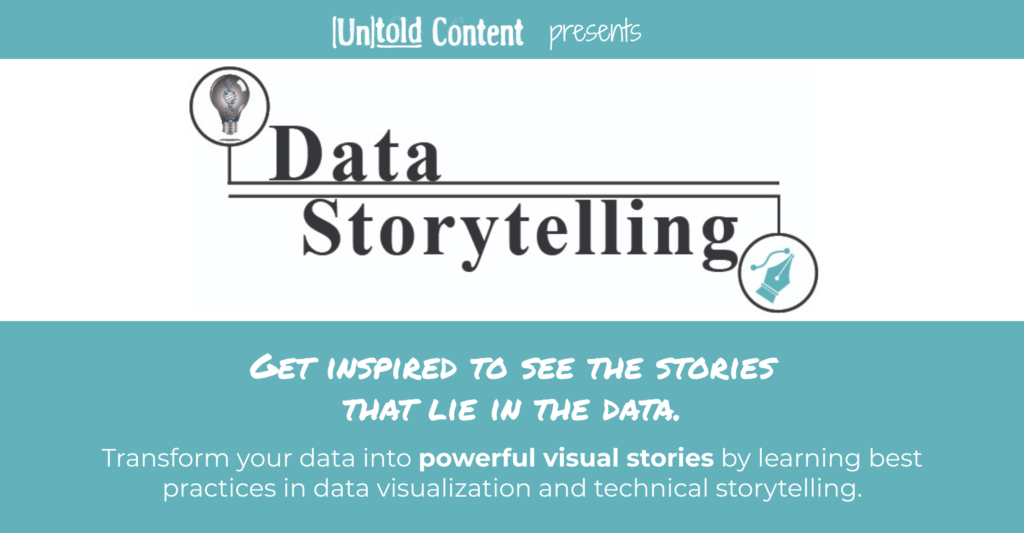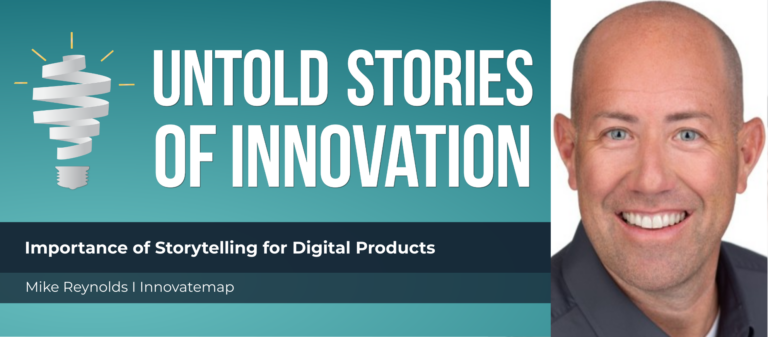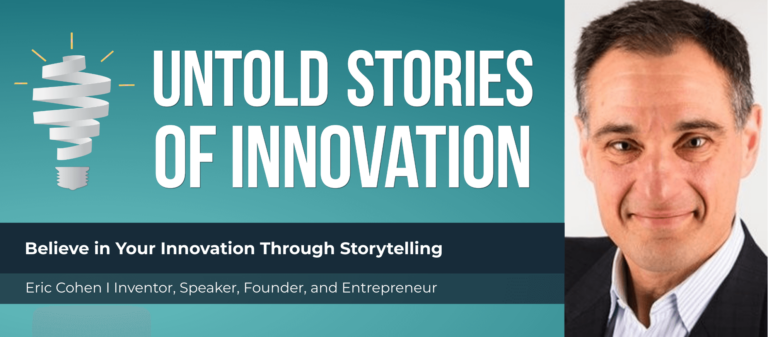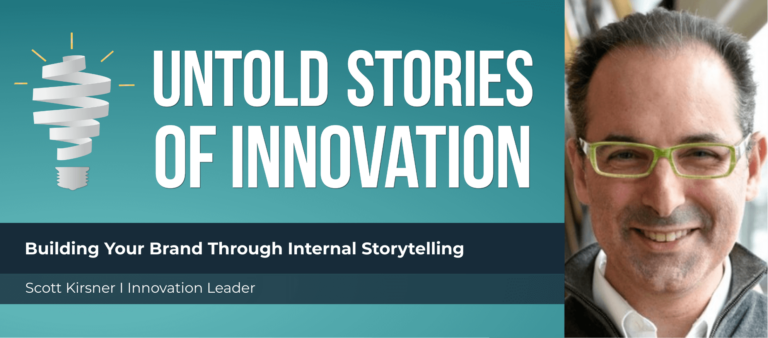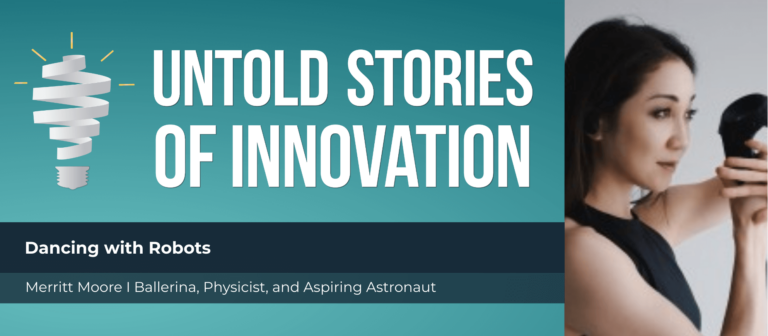Innovation Stories with Dan Carruthers and Adam Pleiman of Gwynne Sound
Untold Stories of Innovation
“When we're creating music and sounds for a brand, we're trying to strike the balance between what the brand stands for and what is the desired consumer response that we're trying to get.” Adam Pleiman, Creative Director of Gwynne Sound
From today’s episode you’ll learn:
Why do stories matter to the innovation process? What values can be instilled in innovators who share stories? How do innovation leaders inspire creators to tell and share their success and failure stories?
Hearing is one of the senses that we cannot choose to easily ignore or “turn off.” Therefore, when curating a contemporary multifaceted brand story, it is important to consider how this sense of sound should be utilized. By understanding sonic brand storytelling, the Grammy-nominated brand Gwynne Sound has created many creative and innovative sounds. Today, we speak with Gwynne Sound’s Dan Carruthers and Adam Pleiman about sonic brand storytelling. When considering user experience, it is important to have an aspect of pathos to the product and branding. Human beings respond emotionally and will remember the feeling evoked, linking it with the innovative product and brand. When considering pathos, do not forget, especially in our digital age, the power of sound in user experience. Knowing this, Gwynne Sound creates a personalized sound brand to elevate your innovative products by utilizing emotion and statistics to narrow down a brand’s message and aesthetic.
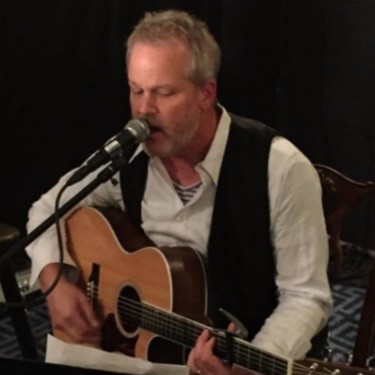
Dan Carruthers spent the first 30 years of his career in the CPG industry. He first served on the "client side" in sales and brand development with Unilever and P&G, and then on the creative side as the Cincinnati GM for New York based MKTG, Inc. A published singer-songwriter, Dan combined his passion for music and his experience in brand-building to become President and CEO of Gwynne Sound in March, 2017. At Gwynne Sound, Dan has led his team to breakthrough innovations and results within two emerging capabilities - sonic branding and high-end podcast production.
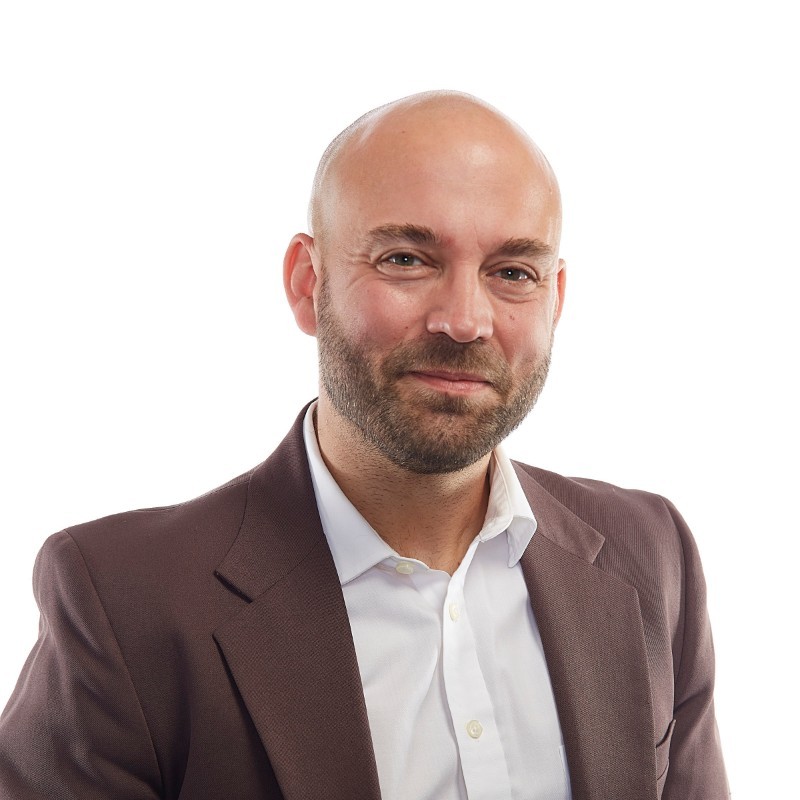
Adam Pleiman’s goal is to channel the ability to connect with others in an organic and truthful sense. Adam is a Grammy-nominated creative professional who has had the absolute pleasure of working for some of the biggest brands (Pantene, Gillette, Roche, Warner Bros, Disney) and biggest bands (Coldplay, 30 Seconds to Mars). Adam has a passion for creating the right strategy, the right people, and the right piece to connect the right person to every project.
untoldcontent.com/trainings/data-storytelling-training
TRANSCRIPT
This episode is powered by data storytelling training from Untold Content and Data+Science. Transform your data into powerful visual stories by learning best practices in data visualization and technical storytelling. Whether you’re a PowerBI or a Tableau person—or just want to better communicate your data—this workshop will inspire you to see the stories that lie in the data. Learn more at https://untoldcontent.com/datastorytellingtraining/.
Katie Trauth Taylor: [00:00:04] Welcome to Untold Stories of Innovation, where we amplify untold stories of insight, impact and innovation. Powered by Untold Content. I’m your host, Katie Trauth Taylor.
Katie Trauth Taylor: [00:00:21] Innovation stories – We’re excited to have two guests today, Dan Carruthers and Adam Pleiman. Dan is CEO of Gwynne Sound and Adam Pleiman is Creative Director. And the two work together with brands or, well, not just the two of them. They have an entire team of creative sonic engineers, sonic artists who work with brands, artists and creatives to create and capture sonic works that leave a lasting emotional impression. I am so thrilled to have you on the podcast to talk about sonic identity and its role in brand identity and the role that it could play in innovation stories. Thanks for being here.
Adam Pleiman: [00:00:58] Yeah, we’re happy to be here.
Dan Carruthers: [00:00:59] Yeah, thank you.
Katie Trauth Taylor: [00:01:00] So tell me, what is sonic identity?
Dan Carruthers: [00:01:03] Innovation stories – Your sonic identity… Think about it as it relates to your brand’s visual identity. So we’ve defined the color palette and we’ve defined logos and how we communicate emotion and your brand character through your visual identity. So a logo isn’t just a red square. That red square typically signifies and communicates something pretty specific to your brand. Take everything that you know about visual identity and it will translate, for the most part, into sound, the broadest goal of the sonic identity is to create a tighter emotional connection to your consumer. Music does that amazingly well. We always say around here that “music tells us how to feel. It doesn’t ask.” You can convey an emotion far faster through music than you can through copy than you can… than you would be able through possibly a visual. But within a few seconds you can make that emotion be understood by your listener and convey that to him. If you do it well, you make him feel it. Right? So…
Katie Trauth Taylor: [00:02:10] Yeah.
Dan Carruthers: [00:02:10] Innovation stories – There’s always moments around here. We always aim for tears in the studios. But yeah. So your sonic identity is that representation?.
Katie Trauth Taylor: [00:02:20] That’s incredible. I think there’s so much focus. There’s so many creative agencies out there focused on brand identity and the aural sound experience of consumers or customers. That’s not necessarily something that’s as amplified, I think, among the creative community. So, you know, tell me a little bit about this space. It’s so interesting that, to me, it doesn’t make sense that that’s not a critical part of a brand identity. In the same way that our team at Untold thinks about a content strategy…
Dan Carruthers: [00:02:56] Oh, yeah.
Katie Trauth Taylor: [00:02:56] Innovation stories – As a critical part of brand identity and thinking of that from the perspective of point of view and tone and how you want your brand to sound in the content that’s created. And so yeah, this to me, it seems like another limb. It’s critical.
Adam Pleiman: [00:03:13] Yeah. And I think people don’t realize that they need it until they experience a pain, you know, so they don’t… from a content side. They start writing and they start putting out what would be a cluttered amount of articles that are not the same tone of voice that aren’t coming from the same person, they don’t feel like the brand, but they don’t really understand that that’s an issue until they find out that they’re not that effective possibly.
Katie Trauth Taylor: [00:03:38] That’s right.
Dan Carruthers: [00:03:38] Innovation stories – Or that there might be a better way to establish themselves with higher credibility over their, you know, over their competitive set and get out in front of them that way by just unifying their voice. A similar thing with sound.
Katie Trauth Taylor: [00:03:52] So whether that’s music in ads or you mentioned sounds that might sort of be part of the retail experience. I’m also thinking – we’ve talked before about the sounds and sort of the sonic experience inside of technology or apps or products that are being created. I mean, especially thinking of the world of smart devices and Bluetooth devices and this connected world that we’re seeing more and more people expect as consumers. And, boy, if the sounds and that grate you or it doesn’t jive. It doesn’t make sense whether that’s in the ad or inside the sort of physical space or on these products that we’re sort of carrying around with us. It can be jarring, confusing, sort of disintegrate trust in a lot of ways. Right?
Adam Pleiman: [00:04:42] Innovation stories – Yeah. So we call that “Sonic UX,”the sonic user experience when it comes to product developments. There’s definitely a responsibility in sonic identity and it comes with a smart strategy and it starts there because you can’t close your ears, but you can close your eyes if you’re completely getting bombarded with billboard after billboard and ads and they’re kind of following you around, what happens is there’s a thing that’s banner blindness, right? So a consumer will scroll past an ad and through use of eye tracking, they found out that they’re not actually seeing the ad and they’re actually avoiding it with their eyes. And you can turn this off, right? So you could turn your phone off. You could turn the device off. You could not look at that billboard, you can’t close your ears. Well, you can, right, but you’d walk around with your fingers in your ear and you’d look like… You’d look silly. So there’s a responsibility there from a fatigue standpoint that we have to only choose the appropriate moments to use this. So in “Sonic UX,” there’s a thing called alarm fatigue. It happens in hospitals all the time. And hospitals are a great example of who could benefit from a sonic strategy.
Katie Trauth Taylor: [00:05:47] And medical device companies, too, that are supplying.
Adam Pleiman: [00:05:49] Absolutely. Yeah.
Katie Trauth Taylor: [00:05:51] That create all of those different alarm sounds. And there’s… yeah.
Adam Pleiman: [00:05:54] Innovation stories – The use of harmony and dissonance in medical is… It’s coming along. But imagine an easier way to create a calmer environment that we perceive as humans to be harmonious. Now it takes coordination across multiple manufacturers.
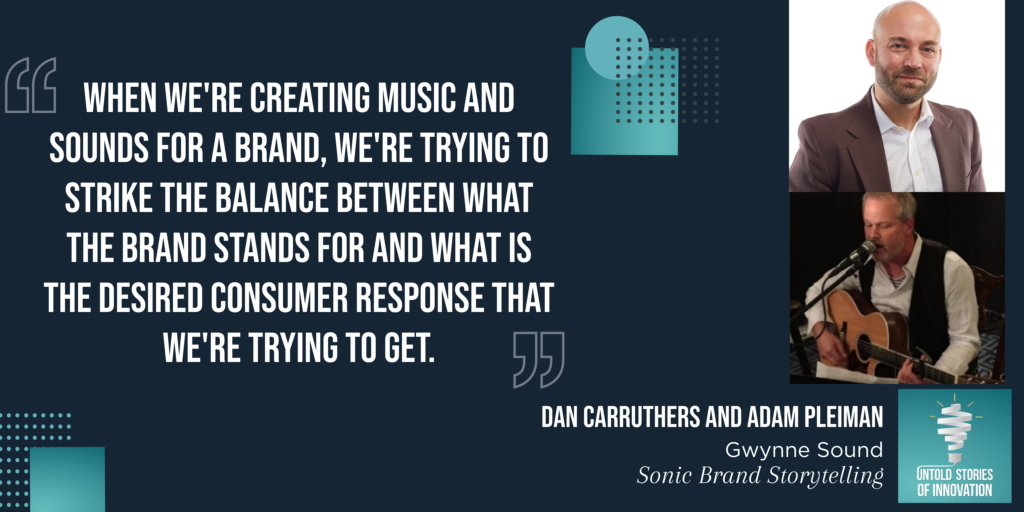
Katie Trauth Taylor: [00:06:09] Sure.
Adam Pleiman: [00:06:09] Innovation stories – To understand how to make this harmonious, but even from the lowest end of this, to create an alarm or a beep, that is at least somewhat pleasing to let you know that all is well, rather than, hey, I’m a beep. And if you can consistently hear these somewhat dissonant, rhythmic things happening, what’s that going to do to your blood pressure? What’s it going to do to your need to be medicated, to keep your blood pressure down in a situation where you’re supposed to be healing? The hospital room is like the worst place for healing.
Katie Trauth Taylor: [00:06:39] That is a great point.
Adam Pleiman: [00:06:40] And these are things that you could do to solve that.
Katie Trauth Taylor: [00:06:42] Innovation stories – That’s incredible. I love that example. You think of the stress that families undergo and the care providers can undergo as well. Like you mentioned, alarm fatigue at some point, nurses and providers, I’m assuming, learn just to sort of ignore the alarms that aren’t relevant. And one of the reasons our team at Untold Content knew we needed to partner with Gwynne Sound to create this podcast is because of your view of innovation, that you are working with innovative companies, you’re working with brands. You’re thinking about how to essentially create more visibility for sonic user experience.
Dan Carruthers: [00:07:24] To your point. So 80 to 85 percent of brands say that music and sound is really important to them, but only 15 to 20 percent actually have a sonic strategy.
Katie Trauth Taylor: [00:07:34] That is so interesting.
Dan Carruthers: [00:07:37] Innovation stories – So it’s important. But what Adam said earlier, it’s like until it really feels like a pain point, getting them to actually act upon that understanding is probably not going to happen.
Katie Trauth Taylor: [00:07:46] Innovation stories – Well, and having access to the talent and the resources and the strategists to bring that to life, I assume is a pain point, because, again, I don’t want to say anything negative about the branding agency world, but you turn a corner on any major city in the US and you will see a branding agency. You won’t see a sonic brand partner.
Dan Carruthers: [00:08:07] Right.
Katie Trauth Taylor: [00:08:07] Innovation stories – So I think this world is emerging and you are at the forefront of it. And it’s really critical to kind of turn to experts like yourselves to help you sort of see what’s possible with your brand.
Dan Carruthers: [00:08:22] Well, thanks.
Adam Pleiman: [00:08:22] We couldn’t agree with you more. Well…
Katie Trauth Taylor: [00:08:26] I speak from experience, right? This podcast, the music, the custom, what do you call it? Something different, not custom music.
Adam Pleiman: [00:08:35] You’ve got branded music, custom music…
[00:08:36] Branded themes…
Dan Carruthers: [00:08:37] Original theme.
Adam Pleiman: [00:08:38] Yeah.
Katie Trauth Taylor: [00:08:38] Innovation stories – Exactly. Everything that you hear throughout this podcast from an oral perspective is thanks to our partnership with Gwynne Sound. And you do far more complex work than just, you know, podcast intros. But so, share some of those stories with us.
Dan Carruthers: [00:08:54] Innovation stories – The interesting thing about the development of these sounds, it’s about how you know what is going to deliver the emotion that you’re looking for, whether it’s going to calm somebody down or get somebody fired up or really get them excited. And I think that’s the cool part of the work that we do, is understanding these cues and how human beings respond to certain audio cues goes way back to the beginning of time. And I think, Adam, if you want to talk a little bit more about that.
Katie Trauth Taylor: [00:09:22] Yeah, sound tells a story.
Dan Carruthers: [00:09:23] It does.
Adam Pleiman: [00:09:25] Yes.
Dan Carruthers: [00:09:25] Has its own innovation story.
Adam Pleiman: [00:09:27] Innovation stories – It really does. So in my brain, I kind of split it up into survival and art. And it really comes from the two different places in your brain where you process them. From the standpoint of survival, if you were to hear a low end rumble of like an avalanche or a tornado or something like that made in nature, whatever’s making that sound, us as people were like, “that is bigger than me and I need to get the hell out of the way.”.
Katie Trauth Taylor: [00:09:53] Right. Right. Go.
Adam Pleiman: [00:09:53] Innovation stories – I got to take cover. I need to find a cave. Got to get away from this. You know, the bear growling is like, wow, that’s a really deep voice. I should probably take off. And in turn, higher-pitched sounds like birds chirping. You know, the slight wind through pine trees whistling softly says all as well. You know, you can come out of the cave, you’re, you know, no birds are going to be flying a tornado. And if they do, they’re going to sound hilarious, you know, like so in nature that happens. And so that’s our survival instinct. But in music, you can convey similar things if you think, for instance, just an easy example would be like the low strings of “Jaws.” Right. So.
Dan Carruthers: [00:10:38] Dun dun…
Katie Trauth Taylor: [00:10:38] Oh no!
Adam Pleiman: [00:10:38] Innovation stories – Right, right. And so what that says to you is like whatever’s going to happen is big, right? It’s bigger than you. And also the melody says it’s inevitable.
Katie Trauth Taylor: [00:10:49] Yes, it’s coming no matter what. No escape.
Adam Pleiman: [00:10:52] Innovation stories – You can do nothing about this, because it’s mighty. It’s big. You know, it’s the deep rumble of the tornado or it’s this avalanche. It’s this thing larger than you. Whereas high strings, flutes, other textures like that, they’re more flighty, they’re light. They’re approachable. They’re easily, easily understood as something that’s safe and happier. And so that’s it’s a very broad, you know, really broad explanation for this. But…
Katie Trauth Taylor: [00:11:18] No, it’s true, it’s instinctive.
Adam Pleiman: [00:11:20] Yeah.
Katie Trauth Taylor: [00:11:21] Innovation stories – So translate that for my enjoyment. Translate that into different brands that we might recognize and how that feels in a brand.
Adam Pleiman: [00:11:32] Innovation stories – The easiest way to probably look at some of this is it kind of holistically. So if you were to think a financial institution where the expectation is that they are solid, right. They’re steady, they’re not going to…
Katie Trauth Taylor: [00:11:50] Reliable.
Adam Pleiman: [00:11:51] Right. You know…
Dan Carruthers: [00:11:54] I’m giving you my money. Please take good care of it.
Adam Pleiman: [00:11:56] Yeah.
Katie Trauth Taylor: [00:11:56] Yeah. Locked down.
Adam Pleiman: [00:11:57] You’ve got a gigantic responsibility. You know, you’re not going to be very whimsical. And so there is going to be a typically an institutional element, although you might be able to wear that on your sleeve a little bit, depending on your brand character.
Katie Trauth Taylor: [00:12:11] Sure.
Adam Pleiman: [00:12:12] But even even if you think of Farmers Insurance, where it is this like the… “We are farmers, right?”.
Katie Trauth Taylor: [00:12:18] Bum, buh dum, bum, bum, bum, bum.
Adam Pleiman: [00:12:19] That’s that’s really it’s tongue in cheek. Right. And it’s just a chorus of dudes singing this. But what they’re singing is very straight, very classic, you know, and it’s you know, “we are farmers,” you know, and it’s a very straight classic thing. I think that does a really great job of balancing out this straight institutional thing with something that’s a little bit more approachable.
Katie Trauth Taylor: [00:12:43] You know, I think to relate this to more traditional branding, I’m thinking of the GEICO gecko since we’re talking about insurance spaces and how what they’re actually dealing with is disaster and heartache and loss.
Dan Carruthers: [00:12:56] Yeah.
Katie Trauth Taylor: [00:12:56] But. It’s really interesting how over the years, branders and teams within insurance agencies have sort of just turned that around a bit. I like how you’re talking about balance. It can’t be too light and fluffy. It’s not the same brand experience as going to buy an iPhone. Right. But at the same time, just because your vertical is dealing with something incredibly serious or maybe, you know, even heartbreaking, there’s others actually sort of an ability to utilize leverage to give people hope or to help them feel again, you need to balance trustworthiness with this sense of hope, I think.
Adam Pleiman: [00:13:42] Yeah. Yeah. And I think…
Katie Trauth Taylor: [00:13:43] We see a lot of creativity in the insurance space in particular.
Adam Pleiman: [00:13:45] Yeah. Insurance latched on to sonic identity like way back and they…
Dan Carruthers: [00:13:49] Farmers, I mean with they may as well just be saying. “Please don’t worry, we have got your back.” You know.
Adam Pleiman: [00:13:58] Which is essentially what they’re saying.
Katie Trauth Taylor: [00:14:01] Yes. OK, then what is the GEICO Gecko saying?
Adam Pleiman: [00:14:02] Well, you know, if you think about the music that supports GEICO, I think people would have a hard time coming up with what it is. So the gecko itself is sort of the representation of the brand. Right. And that’s really to get you to remember GEICO, Gecko, GEICO. Right. But the interesting thing to me is the accent that he brings. So now it’s sort of a tone of voice. So it’s this, like, people respond well to the English accent. Australian accent. You know, I think I believe that the gecko is an Aussie.
Katie Trauth Taylor: [00:14:32] Yeah. I think so.
Adam Pleiman: [00:14:33] Is he not? An Aussie?
Dan Carruthers: [00:14:34] I’m horrible…
Katie Trauth Taylor: [00:14:34] He was, right? Yeah. Definitely. Or, if not, British.
Adam Pleiman: [00:14:38] But it’s very inviting. It seems like. Yeah. OK, I’m responsible and I’m insightful. I’m intelligent. And I’m, more than anything, I’m non-assuming.
Dan Carruthers: [00:14:52] It’s approachable, right? It’s approachable, yet smart.
Dan Carruthers: [00:14:55] So I’m approachable.
Adam Pleiman: [00:14:55] Does it throw you off at one point in time though that the gecko had three separate campaigns running at the same time with three separate, like, somewhat iconic things happening. So you’d have the cavemen bit happening at the same time as the gecko bit happening at the same time. And for a while I kind of thought it was I mean, I thought it was genius enough, because I think what this all culminates, it kind of boils down to, is understanding how to communicate to the expectations of your consumer, you know, because if the brand were to just say, you know, “we are farmers.” Right. Or the brand were to just say, you know, this is who we are and who we represent without any lens of the consumer, you’d have a completely different outcome than you would when you deliver to those expectations and let them dictate, let the consumer and let the research dictate what they expect of you and then counter that against who you are as a brand. That’s when you come up with really great fits and things that work. But I think that’s probably what we saw with GEICO, with that campaign. But that’s also like on the sonic side, what you do all the time. You know, the goal is to create that connection. And you can’t do that unless you have a full expectation of your consumers: who they are, what their values are, what you know, psychographics, who they are and ask them, you know, research it and test it and understand that relationship.
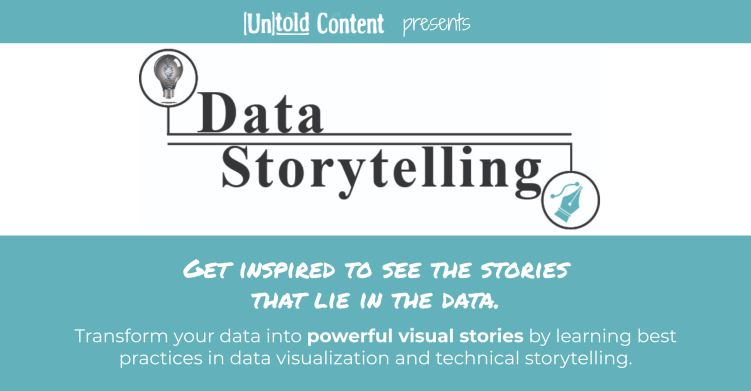
Melissa Pickering: [00:23:34] I think it’s definitely a learning process. I think one of the things that I share with my team is, is making sure, you know, a lot of times you go into presentations and you just want to use the entire 30 minutes or 45 minutes or whatever it may be, just to get as much information out there and to give your whole pitch and squeeze it in. And what I’ve encouraged a team to do is, you know, make sure you’re not taking up the entire time, like leave at least 10 minutes or something, just to understand the questions and the types of questions that are asked, because that’s the biggest opportunity to get a little bit more insight into what each person’s agenda has to then do a loop again. And so you’re… You can continue sharpening the presentation because the worst, and I’ve seen this happen many times and I’ve actually experienced myself, is when you just use all of your breath to say what you want to say. And then, you know, you get feedback later that maybe the idea is not going forward and you don’t really have an opportunity to understand why. And when you have that panel of the leaders in the room that normally have extremely packed schedules, then absolutely take the opportunity to understand the questions and what’s on their top of mind.
Katie Trauth Taylor: [00:24:55] Yes, that’s such good advice, I think, especially as ideas get shelved and communications lacking. And I think there’s a lesson there, too, for those listening to this podcast who are in leadership roles and you are the ones approving innovation projects to make sure that that feedback is very clear to the innovators and the people on your team who are working so hard to come up with ideas. Because one of the most challenging aspects of being innovative is just the resiliency that it takes to accept when something doesn’t get green-lighted and understand when it gets shelved or killed. And so, yeah, I just think that there’s probably advice on both sides of that equation there.
Melissa Pickering: [00:25:35] Yeah, absolutely. That’s a really good point.
Katie Trauth Taylor: [00:25:38] So what other advice would you give to innovators as they prepare to convey their great ideas?
Melissa Pickering: [00:25:50] I think. Yeah, I mean, I guess it’s… kind of goes along with your focus and the focus of this podcast, is not underestimating the power of storytelling. And that is, you know, I think about how I watch many, many, many presentations, too. And the ones that you can really remember are where, you know, you are forced to be transported into a world or relate to a you know, your walk through and experience from the point of view of an eight year old girl. And you just have these little details in the presentation and just help paint a common picture in people’s heads. And I, I just firmly believe that that’s a very powerful way. Maybe it can feel manipulative sometimes, but at the end of the day it is about stirring emotions in your listeners and storytelling is absolutely a powerful way to do that.
Katie Trauth Taylor: [00:26:54] And I think, too, it’s definitely authentic when it’s coming from a place where there’s so much truth to that. I look at my children playing with Legos, and I think if you as an innovator are able to share an insight into what that play looks like and who that person is, I know that from a consumer’s perspective that’s so valuable and not at all something that should be viewed as, you know, storytelling in the sense of lying, right? It’s really about bringing someone’s experience to life and making sure that that aligns really clearly with what the vision is for that innovation. So I love that advice. Thank you so much for sharing that. And thank you for being on the podcast. I am so humbled to have you on. And I can’t wait to hear more of your thoughts as you continue to put out amazing work at Lego.
Melissa Pickering: [00:27:46] Thank you. Thanks for having me on. And I love the mission that you guys have. I think it’s very important. So thank you.
Katie Trauth Taylor: [00:27:53] Thanks, Melissa.
Katie Trauth Taylor: [00:27:56] Thanks for listening to this week’s episode. Be sure to follow us on social media and add your voice to the conversation. You can find us at Untold Content.
You can listen to more episodes of Untold Stories of Innovation Podcast.
*Interviews are not endorsements of individuals or businesses.

